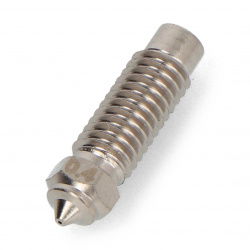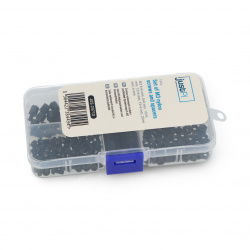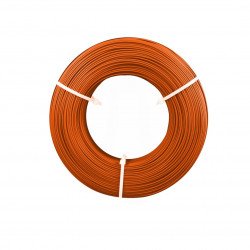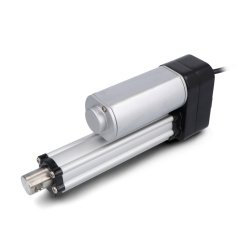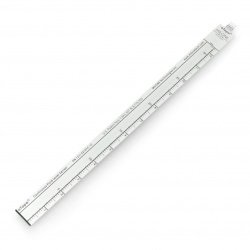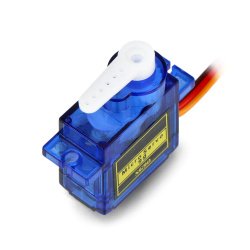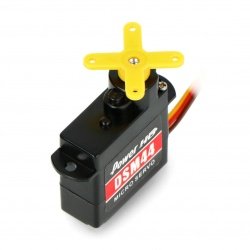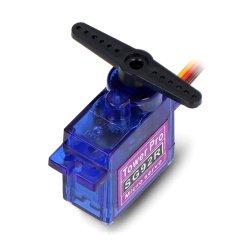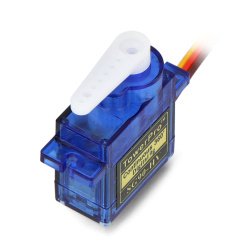Servomechanisms are devices necessary for the construction of DIY electronic projects characterized by a greater degree of expansion. However, it is worth paying attention to the fact that the servos are not equal to each other. This means that we can distinguish many types.
Micro servos
Servo MG-90S - micro - 180 degrees - metal gear
Microservo with a weight of 13.4 g. It features stable operation, accurate working angle and easy installation. It has a metal gearbox. Operating voltage ranges from 4.8 V to...Servo MG-90S - micro - 180 degrees - plastic gear
Micro type servo with MG-90S designation. It has a gear made of plastic elements . The product is characterized by high stability and precision of operation. Supply voltage is...Servo Feetech FS90R - micro - continuous work 360 degrees
Feetech FS90R v2 micro servo. Operates as a variable speed motor. Powered from 4.8 V. Speed: 0.07 s/60°. Torque: 1.5 kg*cm. Dimensions: 30.5 x 12 x 22 mm....Servo PowerHD HD-1440A - micro
Small servo type micro. Supply voltage: 4,8 - 6,0 V. Speed: 0.10 sec/60 °. Torque: 0,8 kg*cm. Dimensions: 8.5 in. x 20,2 x 20,2 mm. Weight: 4.4 grams.Servo PowerHD HD-1370A - micro
One of the smallest available in the world micro servos. Supply voltage: 4,8 - 6,0 V. Speed: 0.10 sec/60 °. Torque: 0,6 kg*cm. Dimensions: 20,2 x 8.5...Servo PowerHD HD-1810MG - micro
Digital, powerful servo type micro. Supply voltage: 4,8 - 6,0 V. Speed: 0.13 sec/60 ° . Torque: 3,9 kg*cm Dimensions: 22,8 x 29,4 x 12 mm Weight:...Servo EF90D 360 - micro - continuous work 360 degrees - with wheel and tire
EF90D Digital Servo Driver and Tyre. It has a 360° rotation angle and uses the pulse width to adjust the speed. The operating voltage is between 3 V and 5.5 V . The...Servo Feetech Wing FT3325M - metal - micro
Servo type micro. The power voltage from 4.8 V to 6 V. Speed: 0.13 sec/60°. Torque: 7,21 kg*cm Dimensions: 30,0 x 10,0 x 35.5 mm Weight: 26.2 gServo Feetech FT90R - micro - continuous 360 degrees
Servo type micro. Power voltage range: 4.8 V to 6 V. Speed: 6 V: 170 rpm Torque: 1.5 kg*cm Dimensions: 22,9 x 12,1 x 26.5 mm Weight: 9 gServo Feetech FT90R-C002 - micro - continuous work - 360°
Micro type servo is perfect for constructions that need a lightweight yet efficient mechanism. An additional advantage of this servo mechanism is the 360° rotation angle ....- Sale
- SPECIAL OFFERS
PowerHD TR-4 micro - digital servo - waterproof
TR-4 digital servo from PowerHD, micro type, powered by voltage ranging from 4.8 V to 7.4 V. It has a waterproof housing. The operating speed and torque depend on the...TowerPro SG50 micro - digital servo
Digital micro servo perfect for projects that require precise control . It offers a torque of 0.7 kg*cm at a voltage of 4.8 V. The set includes mounting screws and...- Reduced price
- SPECIAL OFFERS
TowerPro SG90 micro - analogue servo - 180 degrees
SG90 micro servo with a movement range from 0° to 180° . Perfect for miniature applications related to robotics, modeling or RC vehicles. It offers a torque of 1.8 kg*cm...TowerPro SG90-HV micro - digital servo - 360 degrees
Digital micro servomechanism with a movement range from 0° to 360° . Perfect for miniature applications related to robotics, modeling and DIY. It offers a torque of 1.6...TowerPro SG90 micro - digital servo
SG90 micro servo with a movement range from 0° to 180° , ideal for miniature applications. It offers a torque of 1.8 kg*cm at a voltage of 4.8 V. The set includes...Servo PowerHD HD-1800A - micro
Small and fast servo type micro. Supply voltage: 4,8 - 6,0 V. Speed: 0,08 sec/60 °. Torque: 1,3 kg*cm. Dimensions: 20,8 x 11.5 x 24,0 m. Weight: 8 g.Servo Feetech Wing FT3325P - micro
Servo type micro. The power voltage from 4.8 V to 6 V. Speed: 0.13 sec/60°. Torque: 7,21 kg*cm Dimensions: 30,0 x 10,0 x 35.5 mm Weight: 22 gServo DFRobot SER0049 - micro - 9g 180 degrees
Micro type servo with a total weight of 9g . They are characterized by high torque, stable operation, precise working angle and easy installation. Operating voltage...Torque and rotational speed - the most important operating parameters of servomechanisms
Geometric dimensions, own weight, operating range, supply voltage and control method are parameters that must also be taken into account when choosing a micro servo. As in larger counterparts, the final effect is determined by the torque and rotational speed of the servo. Torque describes how much mass the servo can move using an arm of a specific length - this arm is usually a pusher attached with one end to the servo's linkage and the other to the object controlled by the servo. The rotational speed of the servo is usually parameterized as the time needed to rotate the axis with the T-bar through an angle of 60°. This is a standard adopted by all manufacturers - however, remember to check the servo specifications before purchasing! If you are a beginner in robotics and need a servo to control, for example, the height of a small remote-controlled aircraft with a wingspan of less than 1 m, then it will be optimal to use a servo with a rotation speed of 0.17 s/60°. However, to control the tail rotor of a remote-controlled helicopter, it will be necessary to use a servo with a rotation speed of 0.05 s/60° to instantly counteract the torque of the main rotor.
How to control a servo from Arduino?
The process of controlling the servo directly from Arduino has a simple structure. It is best to connect the servo to Arduino via a dedicated shield, due to the fact that the current capacity of the GPIO outputs in Arduino may be insufficient in relation to the hardware requirements of the servo - the maximum operating current from a single Arduino output is 40 mA. Servomechanisms whose current consumption does not exceed the current capacity of the Arduino outputs can be connected directly. Then, the black servo wire should be connected to the ground pin (GND), the red wire to the supply voltage pin (+5 V), and the yellow wire to one of the pins giving a binary signal at the output. You can also connect the red wire to the pin set as a digital output, set to the logical high state, and the black wire to the digital output set to the low state. When using a servo whose current consumption exceeds the energy capabilities of the Arduino, use an external battery or power supply, but for proper and safe operation, the ground pole of the external voltage source must be connected to the ground terminal (GND) in the Arduino. Another method of controlling servos is to upload a dedicated "servo library" to the program code in the Arduino compiler. This library enables comprehensive control of servos. If you want to control a large number of servomechanisms, it is best to use an external controller and an independent power supply with an output voltage in the range of 4.8 V to 6.0 V.
Micro servos - FAQ
To properly match the servo to a specific RC car model, first of all, you should familiarize yourself with the technical parameters. This applies not only to torque, but also to speed, weight and dimensions. The materials from which the servo gears are made are also crucial. In the case of plastic (e.g. nylon), the servo is characterized by low weight. In turn, metal gears are able to transfer greater torque.
Choosing the right server tailored to the project requirements primarily involves adjusting operating parameters. To properly select a servo, you should pay attention to its geometric dimensions, supply voltage range, servo operating range and the way it can be controlled. The two most important parameters of servomechanisms are torque.
A servo drive is a system that is used to control not only speed, but also position. A servo drive is not a separate device, but a set that consists of a servo motor responsible for processing signals into a specific type of movement. Another element of the servo drive is the servo controller, a device whose main task is to communicate not only with the drive, but also with its power supply. In turn, the PLC controller is the master part that is responsible for sending signals containing commands.
































































































































































































































































































































